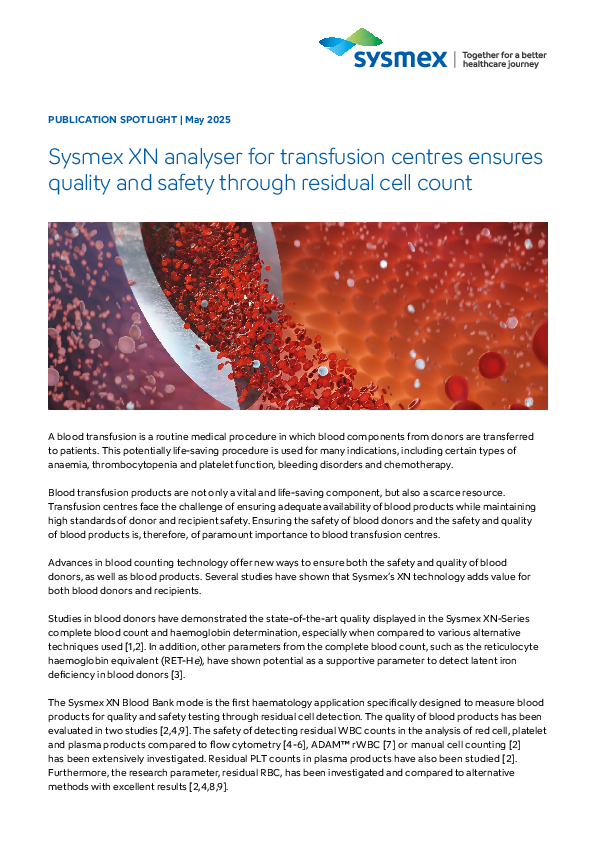Transforming transfusion workflows: The impact of Sysmex Blood Bank mode implementation
In an interview with Gemma Aran Canals, Facultative at Banc de Sang i Teixits (BST) and Margarita Codinach Creus, Head of Laboratory for Cell Analysis at BST, we discovered the benefits of implementing automated blood product measurements, and discussed challenges during the implementation phase and how they were overcome.

The BB mode has transformed our entire workflow for blood component quality control – its automation simplifies analysis, reduces laboratory constraints, and enhances both the efficiency and standardisation of the process.
The BST is a public agency of the Catalan Department of Health, which is providing blood components to public and private hospitals. How many donor and transfusion centres do you have in Catalonia, to ensure sufficient blood availability?
We have 12 fixed donor centers located in major hospitals across Catalonia, complemented by 15 mobile units that set up temporary donation sites daily in different towns and cities throughout the region. Every day, between 800 and 1,000 blood donations are collected across Catalonia, including whole blood donations as well as plasma and platelet apheresis.
How did you ensure quality of your blood products in the past and what were the daily challenges?
Prior to the use of the BB mode, we employed various techniques to obtain all the necessary QC results: residual cell analysis was conducted using specific flow cytometry, staining white blood cells (WBC) with a commercial kit and red blood cells with a monoclonal antibody against CD235a (Glycophorin A). Other parameters, such as haematocrit, haemoglobin, and platelet count were analysed using the Sysmex XN-550 haematology analyser. However, this instrument was not IVD certified for analysing platelet concentrates, plasma, or RBC concentrates, as it was not specifically designed to handle these different matrices. Some challenges included the reliance on an experienced analyst, time-consuming analysis with flow cytometry and the need for extensive sample labeling. Since January 2023, we have been performing blood component quality control using the XN-1000 Blood Bank mode (BB mode), which is an automated system that counts residual cells.
What made you consider trying out the XN-Series Blood Bank mode in your institution?
Automating blood component QC was an ideal solution for us, as we analyse approximately 50–60 samples per day. These samples do not always arrive at the same time, making batch processing sometimes challenging. Additionally, performing two different flow cytometry techniques on each sample every hour was extremely time-consuming. Flow cytometry analysis itself is complex, and training new technicians proved to be difficult. Therefore, the option to automate both the technical process and the analysis of residual cells was a perfect solution for us. Considering all these factors, and the fact that BB mode was in the process of obtaining the IVD-D mark at that time, we saw it as a promising alternative to flow cytometry, and we decided to test and evaluate its performance to determine if it was a suitable fit for our workflow.
Introducing a new device in the lab requires a verification of the device performance. What tests did you run and what were the challenges during this period?
For incorporating the BB mode as a new analytical method for blood component quality control we not only had to validate the analytical method itself but also had to demonstrate that both methods—previously used flow cytometry and BB mode—produced comparable and consistent results.
For a comprehensive method validation, we followed ICH Q2 R2 guideline [1] and assessed parameters such as linearity, limit of detection, repeatability, carry-over, and accuracy. Once this phase was completed, we initiated a method comparison study analysing more than 1,000 samples in parallel.
One challenge was, that by piercing the tube cap multiple times, rubber particles from the cap could fall into the sample and interfere with the residual leukocyte count. Thus, it was crucial to avoid multiple punctures. After one year the BB mode was fully integrated into routine practice and now, we can handle a higher number of samples in less time and in a robust manner.
Where there any special observations regarding platelets?
We observed that the BB mode demonstrated higher residual platelet counts in plasma products, compared to impedance-based measurements. This higher residual platelet count was not an actual increase but rather a consequence of the BB mode PLT-F channel’s greater sensitivity—allowing platelet detection even below a count of 50—whereas impedance-based methods could not.
A similar phenomenon was observed in platelet products, where the platelet count was approximately 17% higher. Again, this was due to the higher resolution and sensitivity of the PLT-F channel, which is based on fluorescence flow cytometry. To further investigate these differences, we conducted a study comparing platelet counts obtained via PLT-F (fluorescence-based), PLT-I (impedance-based), and flow cytometry using CD41a staining (data not yet published). The results demonstrated that PLT-F counts were more closely aligned with flow cytometry-based counts than with those obtained through impedance*.
*Note from the manufacturer: XN PLT-I is not IVD validated to count PLT in blood products and often underestimates PLT counts.
From your point of view, what is the greatest benefit that the BB mode brings to you in everyday practice?
By implementing the BB mode for blood component quality control, we have not only reduced the time but also increased the number of samples we can analyse each day, improving our overall efficiency. One of the most important improvements is the automation of residual cell analysis, eliminating analyst-dependent inconsistencies and ensuring reliable results for high-quality blood component processing. Moreover, the adoption of BB mode has simplified the training process for new analysts. Previously, technicians needed specialised knowledge of flow cytometry to perform the analysis, which could be a barrier to training new staff. With the BB mode, the process is more user-friendly, and the training time is significantly reduced, allowing new analysts to quickly get up to speed and perform quality control tasks effectively.
Thank you very much for sharing your insights with us.
References
[1] European Medicines Agency (EMA) (2024): ICH Q2(R2) Validation of analytical procedures - Scientific guideline

Blood transfusion centres face the challenge of ensuring the safety of blood donors and the safety and quality of blood products. Advances in blood counting technology offer new ways to ensure both. Studies have shown that Sysmex’s XN Blood Bank mode adds value for quality and safety testing through residual white blood cell count. Its performance in the analysis of red cell, platelet and plasma products compared to flow cytometry, fluorescence technique or manual cell counting has been extensively investigated.


